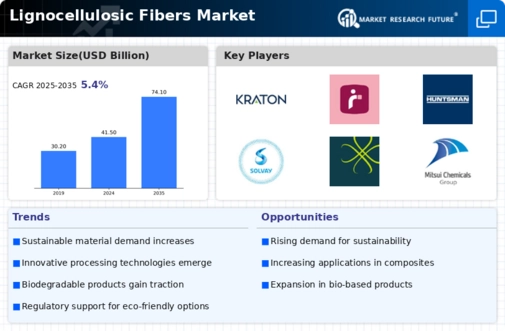Market Growth Projections
Government Support and Policies
Government initiatives and policies aimed at promoting sustainable practices significantly influence the Global Lignocellulosic Fibers Market Industry. Many countries are implementing regulations that encourage the use of renewable resources and the reduction of plastic waste. For instance, subsidies for bio-based materials and tax incentives for companies utilizing lignocellulosic fibers are becoming more common. Such support not only fosters innovation but also enhances market accessibility for new entrants. This favorable regulatory environment is likely to contribute to the market's growth, as stakeholders recognize the economic and environmental benefits of lignocellulosic fibers.
Advancements in Processing Technologies
Innovations in processing technologies significantly enhance the efficiency and quality of lignocellulosic fibers, thereby bolstering the Global Lignocellulosic Fibers Market Industry. Techniques such as enzymatic treatment and chemical pulping have improved fiber extraction processes, making them more cost-effective and environmentally friendly. These advancements not only increase yield but also expand the range of applications for lignocellulosic fibers in textiles, composites, and bioplastics. As a result, the market is poised for growth, with a projected compound annual growth rate of 5.42% from 2025 to 2035, indicating a strong future for processed lignocellulosic materials.
Growing Demand for Sustainable Materials
The Global Lignocellulosic Fibers Market Industry experiences a notable surge in demand for sustainable materials, driven by increasing environmental awareness among consumers and industries. As companies strive to reduce their carbon footprints, lignocellulosic fibers, derived from renewable resources, present an attractive alternative to synthetic fibers. This shift is reflected in the projected market value of 41.5 USD Billion in 2024, indicating a robust interest in eco-friendly products. Furthermore, the anticipated growth trajectory suggests that by 2035, the market could reach 74.1 USD Billion, highlighting the potential for lignocellulosic fibers to play a pivotal role in sustainable manufacturing practices.
Rising Applications in Various Industries
The versatility of lignocellulosic fibers leads to their increasing applications across multiple industries, thereby driving the Global Lignocellulosic Fibers Market Industry. These fibers are utilized in textiles, automotive components, construction materials, and packaging solutions, among others. The growing trend towards lightweight and biodegradable materials in the automotive and construction sectors particularly highlights the potential of lignocellulosic fibers. As industries seek to innovate and meet consumer demands for sustainable products, the market is expected to expand significantly, aligning with the projected growth figures of 41.5 USD Billion in 2024 and 74.1 USD Billion by 2035.
Consumer Preference for Eco-Friendly Products
The shift in consumer preferences towards eco-friendly products is a crucial driver for the Global Lignocellulosic Fibers Market Industry. As awareness of environmental issues increases, consumers are actively seeking products made from renewable resources. This trend is evident in the growing demand for textiles and packaging materials that utilize lignocellulosic fibers, which are perceived as more sustainable compared to traditional materials. Companies that adapt to these changing preferences are likely to gain a competitive edge, further propelling market growth. The anticipated increase in market value underscores the importance of aligning product offerings with consumer values.














